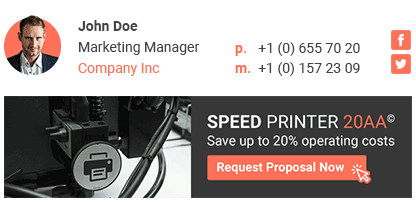The email signature how to – everything you need to know
The email signature: an important component of business correspondence, especially in B2B. Although it looks a bit like a notable footnote in business correspondence, there is a lot to say about it. And if you want to do email signature marketing for your business, it can be useful for you to learn more about it. That's why we've collected background information on email signature in this article.
What is an email signature?
An email signature is the section at the bottom of the email that displays additional information about the sender. If you want to differentiate more precisely, you can differentiate according to the type of information displayed in the signature. Email signatures are not only a voluntary supplement to business correspondence. Also the subject of legal provisions, the term "imprint in the email signature" is sometimes used if the legally prescribed contents are meant. The following article deals with the email signature as a whole, i.e. all four components of which it usually consists. Before we go into these components of email signatures, let's take a look at the historical development.
Historical development of email signature
The email signature is a certain form of the general signature as it is used, for example, in forum posts or in Usenet posts. And this is also where the email signature has its historical origin. In the early days of the Internet, it was predominantly forum users who provided their posts with a personal signature. The reason for this was rather of a practical nature. Usenet only introduced the possibility in 1983 to insert the name and email address of the sender in the header of a post. So users put their personal information in the footer to indicate from whom the post originated and how the author can be reached.This "habit" was then included in email. With ncreasing internet popularity, the signature was used by companies, which emphasized the character of business correspondence in their emails. Incidentally, email signatures were also used for marketing purposes very early on. Hotmail used the insertion of an advertising banner in the footer to significantly increase its reach.
The four components of email signature
Although email signatures look very different, they often have the following four components in German-speaking countries:
- The sender's personal information
- Information about the company
- A disclaimer
- Marketing Information
However, all four components can only be found in the fewest corporate signatures. The reason for this is clear: Only the first two components are legally binding in the EU and must therefore be included in almost all email signatures. The exclusion of liability can, however, usually be dispensed with - from a legal point of view, its necessity is at any rate controversial. As far as marketing information is concerned, there is still a lot of catching up to do. Many companies have not yet exploited this untapped potential, although modern tools such as Mailtastic make it possible to transform email signatures into a powerful marketing tool.Why legislators have made sender details and company information obligatory for email signatures is relatively obvious: These details provide the necessary transparency and allow the recipient to easily and directly distinguish desired emails from spam emails. And that is precisely why email signatures are so important for companies. To a certain extent, it is the pass that companies have to show in order to be able to communicate with customers, partners and other companies.
The sender's personal information
With regard to the personal information required in the email signature, the requirements are kept quite simple. The email signature must of course contain the sender's name and address. The decisive factor here is that the recipient can immediately see how he can contact the sender - the address given in the email signature must therefore also be identical with the details in the commercial register (of course only if the company is entered in the commercial register). Further additional information such as a link to a Xing or LinkedIn profile is optional and can of course be added to the personal information.
Legal information
While the personal details of the sender are still relatively clear, the legal details in the email signature are somewhat more complex. The legal information that must be included varies depending on the legal form of the company.Basically, there is only one mandatory legal statement for all forms of company: The company name. Every company must include this in its email signature, regardless of its legal form. The address including the place of jurisdiction is also mandatory for almost every company - with the exception of registered merchants.
The registered merchants are also exempted from having to state the name of the managing directors or the chairmen of the board of directors in their email signature. For all other forms of company, the following applies: The managing persons must be named.Im Germany, the sole proprietorship and the GbR, on the other hand, can dispense with the specification of the place of jurisdiction and the commercial register number. This information is mandatory for all other forms of company.In addition, there is also the requirement that the legal form of the company must appear in the imprint in the email signature - if it is not a sole proprietorship. This means:
- GbR must indicate its legal form "GbR" in the signature.
- GmbH must specify "GmbH".
- The same also applies to the legal forms AG, PartG, eG, SC and SCE - they must all refer to their respective legal form in the imprint in their email signature.
Legal information is therefore relatively varied. But it makes sense to deal with it: If you do without it, you make yourself legally vulnerable.
The disclaimer
While the requirements for the employee's personal data and the legal form of the company are clearly formulated by law, the requirement of a disclaimer is legally unclear. Many companies use such a disclaimer in the hope of being able to protect themselves from the consequences of misdirected emails. A typical disclaimer looks like this:"Note: This message or its attachments may be confidential in content, or otherwise worthy of protection. If you are not the intended recipient of the message, or have accidentally received the message, you may not forward, copy, or otherwise distribute the content of the message. If you have accidentally received this message, please notify the sender and delete the message and attachments. Thank you very much".Well formulated and sonorous is that yes - but unfortunately also questionable in its legal effectiveness: The effectiveness of a disclaimer in email signatures is controversial. For the exclusion of liability to make legal sense, the agreement between sender and recipient would have to have been made. However, this is precisely not the case with the exclusion of liability: this is a unilateral declaration by the sender. And it is not binding.This is the majority opinion at present: The exclusion of liability in email signatures is not a legal obligation. Inserting it is certainly not harmful, but it should be clear that it probably has no legal relevance.
Email Signature Marketing

Marketing within the email signature, on the other hand, is of course not legally binding. And there is not much demand for it either - most companies have not made use of this option so far. But they are wasting valuable traffic potential. A company with only 50 employees, for example, sends about 500,000 emails per year and thus has 500,000 chances to place its messages and increase its turnover. The signature offers a very good opportunity to generate eye-catching banner impressions and clicks for every campaign that is important to a company. Starting with current offers, through the new whitepaper to job offers and awards, practically everything can be promoted with a good email signature. So why do so few companies use their email signatures for marketing purposes?There are several reasons why email signatures are not the favorite of many marketing departments. Most importantly, advertising in email signatures often requires a lot of administration.
Effective Email Signature Marketing
In order to use signature advertising effectively, it is not sufficient to place a banner in the emails of all employees. Rather, each department should receive its own signature in order to be able to develop its effect according to the target group.The problem is, however, that marketing depends on the implementation by the individual employees. And they usually have higher priorities than exchanging their signatures at regular intervals. And then there are colleagues who have technical problems and finally send emails with broken signatures (without knowing it). In addition, the performance of the banner must of course be checked, which in turn means that new properties have to be constantly created in the analysis tools and the click rate still cannot be measured.So even if email signature marketing or signature advertising looks like little work at first glance, in reality a whole rat's tail can hang on it and keep the marketing team from their actual tasks.Such problems can be avoided with a solution such as Mailtastic - attention-grabbing banners can be created centrally for each individual employee in the email signatures from marketing and the performance can then be traced in impressions, clicks and click rates using the integrated analysis. In this way, this area of the email signature can finally be used for marketing in an uncomplicated way.But one question remains unanswered:
What threatens if the email signature does not comply with legal requirements?
Very simple: warnings and even complaints. If you don't comply with legal requirements and don't even have a signature in your email at all, you may have to prepare for fines.A penalty can cost you up to 1,000 Euros, for huge enterprises even a penalty of up to 5,000 Euros threatens.However, this is not necessarily a reason for panic. Because such punishments, explains the lawyer, take place usually then, if the enterprise can submit also after a warning still no legally perfect business letter. And if only insignificant, individual details are missing, a warning is usually not even justified at all.Nevertheless, even if there are usually no serious legal consequences to be expected, it is in the interest of every company to ensure that the email signature is flawless. Not only to ensure legal certainty. After all, the email signature, which is in line with the legal requirements, is in itself a figurehead for a serious and professional company.
Conclusion
The email signature is one of many areas of business correspondence, but maybe the most important. Like many other areas, it is legally regulated. Having a legally correct email signature is not only necessary for reasons of professionalism - it is also protection against expensive warnings or fines.It makes sense to make full use of the marketing area of email signatures - after all, this is an advertising space that belongs to your company anyway. Mailtastic helps you to fully exploit the potential of your signature and to turn your signature into a real marketing channel.
Need a professional email signature?
We support you in creating a legally compliant and maintained uniform signature for all employees.



_Card.png)